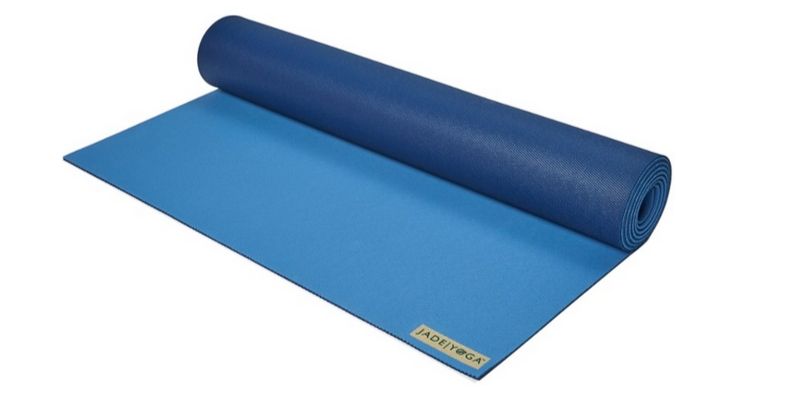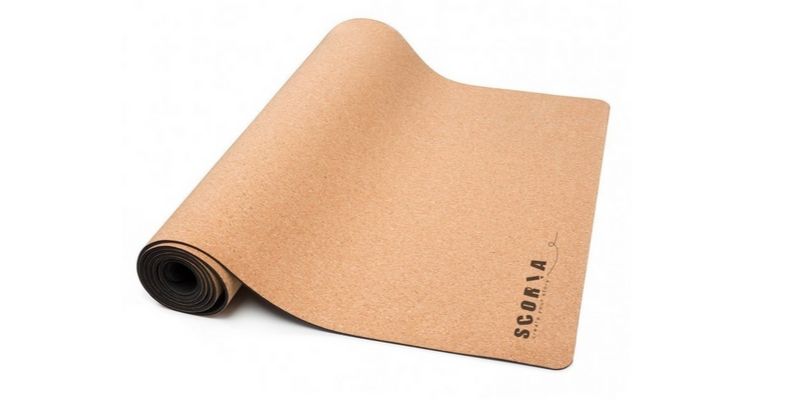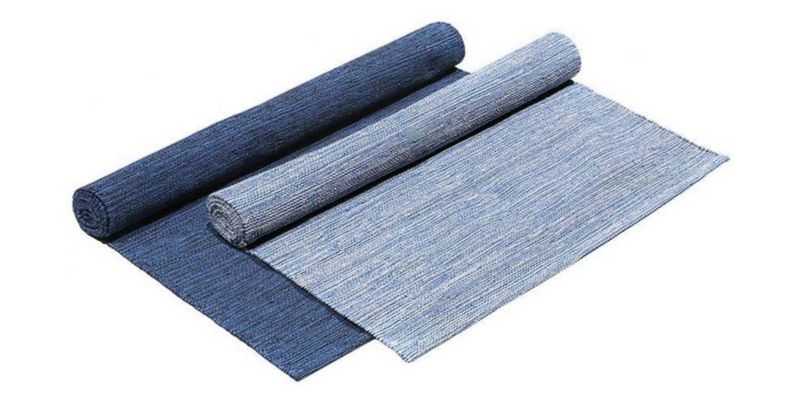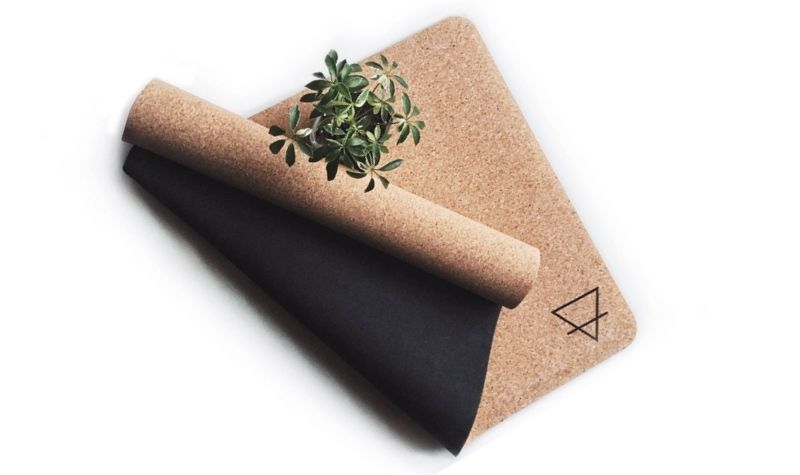This post contains affiliate links. I'm not paid to promote products and only recommend ones I believe in.
Elevate your practice with of the best eco-friendly yoga mats. Honor your body, your mind, and our environment with these supportive, non-toxic yoga mats.
According to a survey conducted by the Yoga Alliance, 1/3rd of Americans has tried yoga. This number is steadily rising, so if you haven’t hopped on the yoga train yet, chances are you will soon. Whether you are a beginner or a seasoned practitioner, you probably know yoga is more than a great workout. It’s part of a holistic lifestyle, conditioning the body and mind. But you might not know yoga can come with hidden risks. Many people are surprised to hear their yoga mats are made with toxic chemicals that are harmful to health and the environment. So whether you’re a first-time shopper or just looking to make a switch, choose from these top-rated yoga mats made from safe, eco-friendly materials.
Quick Links
Round Up: Best Eco-Friendly Yoga Mats (2019)
Over the course of my 15 years practicing yoga, I have spent countless hours researching yoga mats. Based on my research, these are the best yoga mats for beginners and expert yogis. All of these yoga mats are durable, moisture-absorbent, and made with sustainable, natural all materials. These mats vary mainly in terms of cushion, upkeep, and portability. So make sure you read my take on their pros and cons before you make your final pick.
| Mat | Materials | Price |
| JadeYoga Harmony Mat | Natural Rubber Proprietary Components | Check Price |
| Scoria Essential Cork Yoga Mat | Natural Cork Natural Rubber | Check Price |
| Ekaminhale Organic Yoga Rug | Organic Cotton | Check Price |
| Urbivore Sustainable Yoga Mat | Natural Cork Natural Rubber | Check Price |
In addition to these frontrunners, I also considered the Manduka EcoLite Pro, Hugger Mugger Para Rubber Mat, and the Yoloha Nomad – all of which have more synthetic components than I prefer. This said, these three mats are also highly-rated. I believe they are worth a look if you aren’t sold on the one on my formal list of recommendations.
The Benefits of Yoga
Before I get to yoga mat reviews, let me take you a quick detour. Because, although, it has soared in popularity in recent years, few practitioners know why yoga is so beneficial. The benefits of yoga are well-documented – psychologically, physiologically, and spiritually. If you’re just getting started on the journey, these all the positive effects in store for you:
- Physical Health: Seasoned yogis enjoy greater muscle strength, better posture, and healthier bones and joints. There is also scientific evidence that yoga can improve cardio-metabolic health, lowering blood pressure and cholesterol. In fact, subjects in a recent study saw an average drop in systolic blood pressure from 126 to 121 and in diastolic pressure from 82 to 79 after 12 weeks of practicing hot yoga. These results were compared to a control group, which saw no changes in blood pressure at all1
- Mental Health: One of the most immediate effects of yoga is reduced stress and anxiety. It is shown to decrease the secretion of cortisol, the primary stress hormone that is also implicated in depression. In fact, a study found that after just 10 weeks of practice, 52% of the subjects who were initially diagnosed with PTSD no longer met the criteria for the condition at all2.
- Better Quality of Life: A regular yoga practice that incorporates mediation has been linked to improvements in overall well-being, particularly sleep. In one study, subjects participated in 12 weeks of bi-weekly classes and showed significant improvements in sleep duration and sleep quality compared to a control group3
RELATED: Practical Feng Shui Bedroom Design Tips for Better Sleep & Restoration
It is clear that yoga is more than just a pastime. It’s a powerful, evidence-based healing tool, too. But to enjoy the benefits, you have to make it personal – and that means picking the right type of yoga practice and the best yoga mat for you.
The Different Types of Yoga
Many practitioners aren’t fully aware of just how many types of yoga there are. It can be daunting to figure out which style is best-suited for you, but giving it thought in advance of buying a yoga mat will ensure you pick a mat that is tailor-made for you.
- Vinyasa yoga, sometimes called “power yoga” is known for active poses and fluid transitions supported by deep breath. Classes involve a variety of challenging postures, including arm balances, inversions, and stretching. No two vinyasa classes are the same, and music is often played to add dimension. Occasionally, rooms will be heated to 80-100 degrees in order to loosen muscles and boost detoxification.
- Bikram yoga follows a patented sequence of 26 time-tested poses. Classes take place in rooms heated to 105 degrees at 40% humidity. In traditional Bikram yoga, music is not played and there is very little interaction between practitioners and instructors. This is one of the most popular types of yoga, but because of the intense environment, it is not typically advised for beginners.
- Ashtanga yoga also follows a specific sequence of postures. It is often compared to Vinyasa, because it links movement to breath and features similar poses. The main difference between Ashtanga vs Vinyasa is that every Ashtanga class is the same. If you like to be challenged and stick to a routine, this is a great style to consider.
- Restorative yoga involves very few poses, because each pose is held for 5 minutes or more. Props, like blocks and blankets, support your body throughout gentle postures, allowing you to unwind and decompress. Restorative yoga is ideal if you are looking for something more mentally challenging than physically taxing. However, if prefer something a little more upbeat, consider yin yoga, a variation on this style
Although there are many other styles of yoga, these are the most common ones in the United States. With time, you can master any of these unique styles. It just takes patience, persistence, and a few supportive props, the most important of which is a yoga mat.
What Makes the Best Yoga Mats?
So what are the qualities of the best yoga mats, and do those qualities vary for beginners and experts? The answer depends on which types of yoga you plan to practice as well as your lifestyle and daily habits. The main features to consider are thickness, traction, and construction. Of course, it’s important to look for eco-friendly, non-toxic yoga mats too.
Thickness
The thickness of a yoga mat impacts comfort, stability, and portability. So think about what type of practice you’re most into. Thin yoga mats allow solid contact with the floor and are best for maintaining balance throughout active flowing poses. On the other hand, thick yoga mats are easier on sore joints and are more comfortable for meditation and restorative poses. For beginners, the ideal thickness of a yoga mat is around 3.5-4.5mm This is thin enough not to inhibit stability while offering a sufficient amount of cushion.
Traction
Depending on how heavily you sweat or plan to sanitize your mat, you’ll also want to consider open-cell vs. closed-cell construction. Open-cell yoga mats are preferred for heated classes, because they are porous and therefore they absorb moisture. Conversely, closed-cell yoga mats do not absorb moisture (or bacteria), which makes them much easier to clean. However, in heated yoga classes, closed-cell mats get slippery. If you choose a closed-cell mat, I recommend pairing it with an organic cotton yoga mat towel or rug.
Non-Toxic Materials
Materials impact traction and floor grip as well as the quality of your experience. Trust me, there is nothing less zen than spending a yoga class tripping or slipping on your mat! Because your yoga mat comes into direct contact with your skin and will constantly be in your immediate breathing zone, choosing one made of non-toxic materials is essential.
Unfortunately, most popular yoga mat brands are made with petroleum-based materials like polyvinyl chloride (PVC), synthetic rubber, and thermoplastic elastomer (TPE). Not only are these materials linked to serious health risks, but they also wreak havoc on our environment. Eco-friendly yoga mats are the way to go; they come in the following flavors:
Natural Rubber Yoga Mats
Natural rubber yoga mats are well-cushioned and offer excellent stability. Most are made with open-cell construction, which also aids in floor grip. One the most distinctive benefits of natural rubber yoga mats is their durability. But be aware that these mats are usually heavy and can contain still chemical additives that smell unpleasant. I found this out after testing this popular yoga mat, which is high on my list of recommendations; it is excellent from a performance standpoint, but it does retain a rubbery smell for several months.
Cork Yoga Mats
Cork yoga mats are extremely eco-friendly, because cork trees regrow their bark after it’s stripped away. In the process, the trees also absorb more carbon dioxide, leaving a positive imprint on the environment. Cork yoga mats contain suberin, a waxy substance that is activated by moisture and enhances floor grip. They are ideal for heated yoga classes, especially because they are naturally anti-microbial. However, some are made with synthetic rubber or TPE backing, which adds weight and results in a poor chemical profile. In my opinion, the best yoga mat will have a cork surface and natural rubber backing.
Jute Yoga Mats
Jute yoga mats are very lightweight, so they are a top choice for yogis who walk to class. You do give up some cushion and padding for the extra portability, though. These mats are extremely affordable, but I am not inclined to recommend them. Compared to other non-toxic materials used for yoga mats, jute is considerably less durable and less absorbent.
Jute yoga mats can get slippery during active yoga classes, and their rough-textured fibers are prone to shedding. Most are also made with polymer environmental resin (PER), which isn’t as innocuous as it sounds. PER is actually a form of polyvinyl chloride (PVC) that is processed in a more environmentally-friendly way. So, any yoga mat with PER can’t technically claim that it is a “PVC-free,” which I believe is an important characteristic 4.
Organic Cotton Yoga Mats
Organic cotton yoga mats are uncommon, but they are a viable option if you want something natural and highly portable. Cleaning this type of mat is just about as easy as it gets. Just throw it into a washing machine and voila. So convenient! For these reasons, organic cotton is an ideal material for outdoor and travel yoga mats. The biggest downsides of these mats are their poor traction and long-term durability. Although they are great at absorbing moisture, they can bunch up in motion and are prone to fraying.
Reviews: Best Eco-Friendly Yoga Mats
Now that it’s clear what to look for in a yoga mat, let’s take a closer look at the top-rated eco-friendly ones available. Whether you are a beginner or you have several years of practice under your belt, these are your best bets for a safe, chemical-free yoga practice.
Jade Harmony Natural Rubber Yoga Mat

| Thickness | Materials | Made In |
| 4.7mm | Natural Rubber & Proprietary Components | USA |
JadeYoga is one of the most established sustainable yoga mat companies around. What began 100 years ago as a family-owned oriental rug business is now a non-toxic yoga mat and accessories brand trusted by millions of practitioners around the world.
The Harmony Yoga Mat is JadeYoga’s most popular product, and for good reasons; it is made in the USA (a big plus!) of natural rubber and is free of PVC, phthalates, heavy metals, and flame retardants. Through a partnership with Trees for the Future, JadeYoga also plants a tree for every yoga mat sold, making this an unquestionably eco-friendly choice.
Unfortunately, JadeYoga does add some proprietary synthetic components to this natural rubber yoga mat. I honestly find this a little disappointing, but the company claims that the components meet food-grade standards set by the FDA.
The Jade Harmony Yoga Mat is highly-rated by beginners and experts alike. Practitioners rave about excellent floor grip, absorbency, and durability. However, the mat has a rubbery smell that lingers, and its open-cell construction makes cleaning a bit challenging.
Dense natural rubber makes this yoga mat a little heavy, too. If you are looking for something more lightweight and portable, JadeYoga’s travel yoga mats or organic mysore yoga rugs may ultimately be a better pick.
Pros
- Outstanding grip and absorbency
- Decent cushion
- Excellent durability
- Charitable, eco-friendly causes
Cons
- Lingering rubbery smell
- A few synthetic components
- Difficult to clean
- May attract lint and dust
- On the heavy side
Scoria Essential Natural Cork Yoga Mat

| Thickness | Materials | Made In |
| 4.5mm | Natural Cork & Natural Rubber | China |
I’m a little partial to the Scoria Essential Natural Cork Yoga Mat, because it is the one I currently use. It is incredibly eco-friendly, featuring a cork surface and natural rubber backing, and it comes in plastic-free packaging. There is also no PVC, PER, TPE or harsh chemicals in this mat, so it has an exceptional chemical profile.
I chose this yoga mat not only because of its eco-friendly materials but also because I adore Scoria’s mission. The company creates products that encourage grown-ups to embrace a youthful mindset. I am definitely on board with that! To spark creativity and imagination, Scoria offers a wide selection of mats with gorgeous artwork and imagery. The Blossom is one of my favorite designs; I love the modern look of the Revolve yoga mat, too. Depending on the mat, varying levels of cushion may be available. I prefer the 4.5mm thickness of the Essential mat, but for greater floor contact, 3.5mm is an option, too.
I am genuinely happy with my Scoria World yoga mat, but there are a few downsides that I must point out. First, the mat is made in China, where I feel manufacturing processes are less trustworthy. Even still, I ended up choosing it over this other high-quality cork yoga mat that’s made in the USA but has synthetic rubber backing. Secondly, these yoga mats are a little hard to come by. Scoria is a small Canadian company, so inventory is limited.
Pros
- Naturally antimicrobial
- Fantastic floor grip and stability
- Easy to clean
- Gorgeous artistic designs
Cons
- Made in China
- Limited inventory
Ekaminhale Organic Cotton Yoga Rug

| Thickness | Materials | Made In |
| 3mm | 100% GOTS-Certified Organic Cotton | India |
It is virtually impossible to find a cushioned organic yoga mat, but Ekaminhale Organic Cotton Yoga Rugs are as authentic as you can get. These thick yoga rugs are hand-loomed of 100% GOTS-certified organic cotton, and the dyes used are completely natural, too. It is interesting that the story of Ekaminhale itself is organic. The founder seems to have stumbled upon his calling; for him, “practice first; everything else comes after.”
Ekaminhale Organic Yoga Rugs are pure fabric, so they are great for outdoor use and they work nicely as travel yoga mats. On its own, a rug like this wouldn’t be my top choice for an active Vinyasa class; however, it would make an excellent organic yoga mat towel, especially if you own a closed-cell construction mat or want to avoid scrubbing your open-cell one.
Pros
- 100% GOTS-certified organic cotton
- Handcrafted construction
- Highly absorbent
- Extremely portable
- Doubles as a yoga mat towel
- Easy to clean
Cons
- Lacks cushion on its own
- May move around during practice
Urbivore Sustainable Yoga Ma

| Thickness | Materials | Made In |
| 4mm | Natural Cork & Natural Rubber | Probably China (Unconfirmed) |
The passion project of two eco-conscious sisters, Urbivore is a newer brand coming our of Canada. Urbivore’s handmade natural cork yoga mats require very little upkeep and come in a variety of minimalist designs. They are reliable, non-slip yoga mats without chemicals, PVC, or synthetic materials. They come with outstanding reviews from happy “omies”, too.
Unfortunately, the founders of Urbivore have been unresponsive to my inquiries regarding where their sustainable yoga mats are made. I will update this post as I receive more information, but at the moment I am inclined to believe that the mats are made in China.
Pros
- Naturally antimicrobial
- Minimalist designs
- Great floor grip and stability
- Easy to clean
Cons
- Most likely made in china
- Limited inventory
Did I miss any eco-friendly yoga mats? Share your favorite one with me and tell me what makes it the best non-toxic yoga mat for you.
Sources: (1) Hypertension: Hot Yoga and Hypertension: Exploration of a Novel Lifestyle Intervention, (2) National Institute of Health: Yoga as an adjunctive treatment for posttraumatic stress disorder, (3). PubMed: Yoga for improving sleep quality and quality of life for older adults, (4) Appropedia: Polymer environmental-friendly resin
